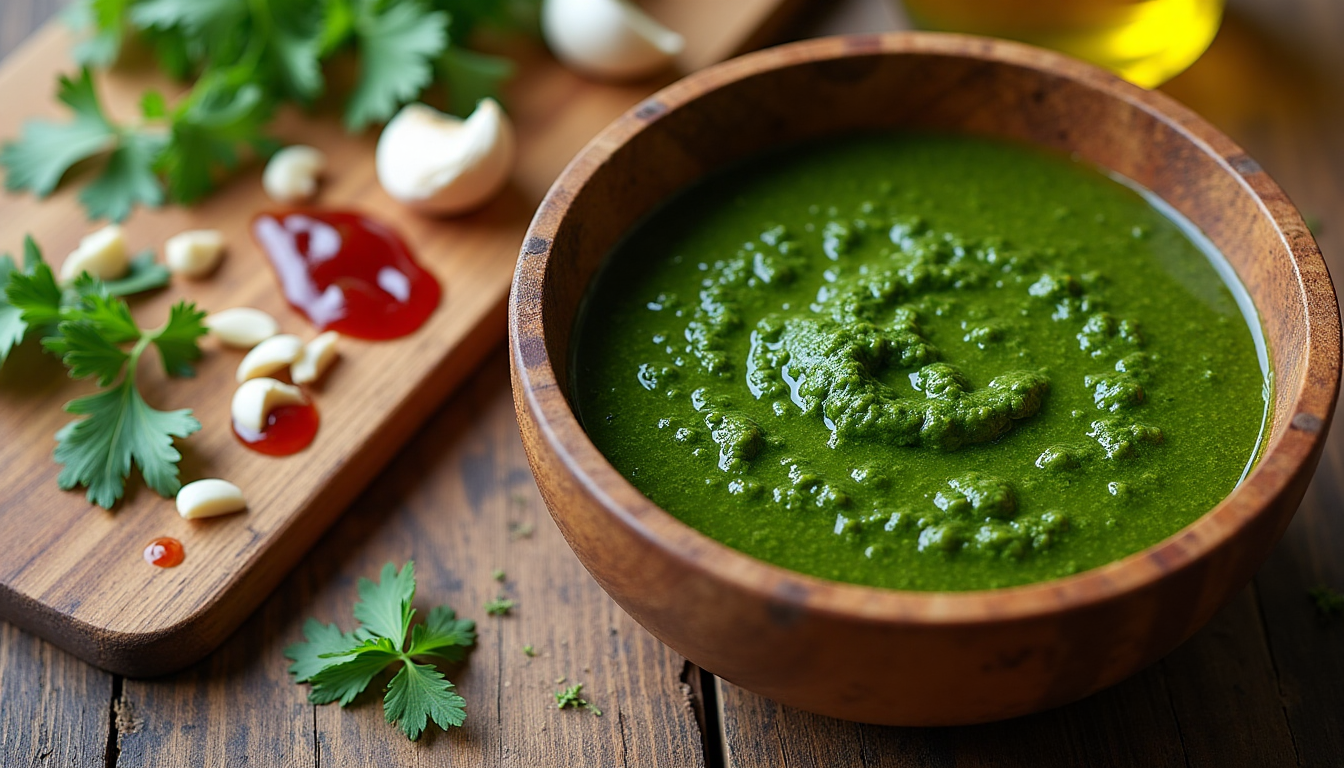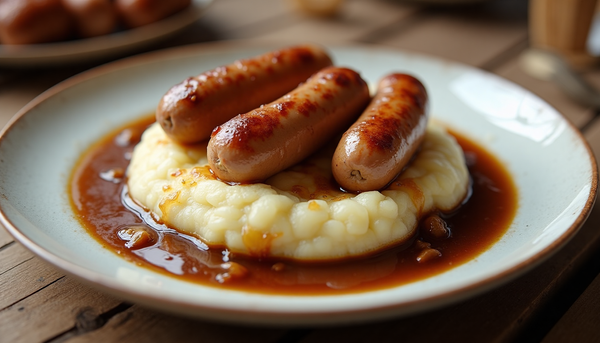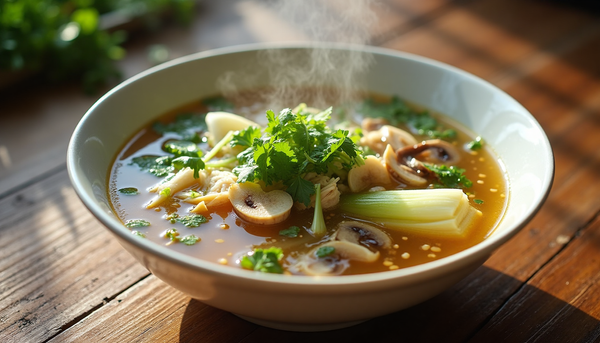Why This 5-Minute Sauce Changed How I Think About Cooking

Why This 5-Minute Sauce Changed How I Think About Cooking
I used to be that person. You know the type — standing in the grocery store sauce aisle for twenty minutes, reading labels like I was decoding ancient hieroglyphics, trying to find the "perfect" marinade for Tuesday night's chicken. Sound familiar?
Then I discovered chimichurri. And honestly? It kinda blew up everything I thought I knew about flavor.
The Simplicity Revolution (That's Been Hiding in Plain Sight)
Here's what nobody tells you about chimichurri: it's not just a sauce. It's basically a masterclass in why simple cooking often beats the fancy stuff. Six ingredients. Five minutes. Zero cooking required. Yet somehow it makes everything taste like it came from a restaurant kitchen.
The traditional Argentine version is almost embarrassingly simple:
- Fresh parsley (lots of it)
- Garlic (don't be shy)
- Olive oil (the good stuff matters here)
- Red wine vinegar
- Salt and pepper
- Maybe some oregano if you're feeling fancy
That's it. That's the whole thing.
But here's where it gets interesting...
We've Been Doing This All Wrong
When did we decide that good food has to be complicated? I blame the Food Network. (Kidding! Sort of.) We've somehow convinced ourselves that if a recipe doesn't have fifteen ingredients and three hours of prep time, it can't possibly be impressive.
Chimichurri laughs in the face of that logic.
I remember the first time I made it — literally whisked everything together in a bowl while my steak was resting. Took maybe three minutes. When I drizzled that bright green sauce over the meat, it was like watching culinary magic happen. The herb-forward freshness cut through the richness of the beef, the garlic added this punchy depth, and the acid from the vinegar just... made everything sing.
My dinner guests were convinced I'd spent hours on that sauce. Nope. Three minutes and a whisk.
What Makes It Actually Work
The genius of chimichurri isn't in any single ingredient — it's in the balance. Each component has a job:
The parsley isn't just for color (though that vibrant green is gorgeous). It brings this grassy, almost mineral quality that grounds everything else. Fresh parsley tastes like... life, if that makes sense. Bright and clean and unmistakably fresh.
The garlic provides the backbone. Use good garlic. Mince it fine or grate it — you want those oils released. This isn't the time for garlic powder.
The olive oil is your canvas. It carries all those flavors and creates that silky texture that makes you want to put chimichurri on everything. (Pro tip: you probably will.)
The acid — whether from red wine vinegar, lemon juice, or both — is what makes your taste buds wake up. It cuts through richness and brightens everything.
But here's what I've learned through probably way too much experimentation...
My Chimichurri Adventures (And Happy Accidents)
The beauty of chimichurri is how forgiving it is. Ran out of parsley? I've mixed in cilantro. No red wine vinegar? White wine vinegar works. Sherry vinegar is actually incredible. Sometimes I add a squeeze of lime because why not?
One night, I was making chimichurri and realized I was out of shallots. Panic mode. Then I remembered I had some green onions that were getting a bit sad in the fridge. Chopped up the white parts, tossed them in. Game changer. The green onions added this subtle sweetness that balanced the sharpness of the garlic.
Another time, I accidentally doubled the oregano. Instead of starting over, I just rolled with it. Turns out, extra oregano gives chimichurri this almost Mediterranean vibe that's amazing with fish.
The point is: chimichurri wants you to succeed. It's basically impossible to mess up as long as you keep the basic ratios in the ballpark.
Beyond the Steakhouse
Here's where most people stop: they make chimichurri, put it on steak, call it a day. But that's like buying a Ferrari and only driving it to the grocery store.
I've put chimichurri on:
- Scrambled eggs (trust me on this one)
- Roasted vegetables (game changer for Brussels sprouts)
- Grilled fish (obviously)
- Pizza (before you judge, try it)
- Pasta salad (who needs Italian dressing?)
- Avocado toast (because millennials gonna millennial)
My current obsession? Chimichurri butter. Mix some chimichurri into softened butter, roll it in plastic wrap, chill it. Now you have herb butter that makes everything better. Corn on the cob will never be the same.
The Cultural Connection
What I love about chimichurri is its story. It comes from Argentina and Uruguay, where grilling meat isn't just cooking — it's practically a cultural institution. Asado culture is about taking time, gathering people, keeping things simple but doing them right.
In a world where we're constantly rushing, constantly complicating, chimichurri reminds us that some of the best things happen when we slow down and let good ingredients speak for themselves.
There's something deeply satisfying about making a sauce that's been made the same way for generations. No modern shortcuts needed because the original version was already perfect.
The Storage Game
Real talk: chimichurri gets better with time. Make it in the morning, use it at dinner. The flavors meld and develop. It'll keep in the fridge for about five days, though good luck making it last that long.
Pro tip I learned the hard way: the olive oil might solidify a bit in the fridge. Just let it come to room temperature and give it a stir. Crisis averted.
Want to get really organized? Make a big batch and freeze it in ice cube trays. Pop out a cube or two whenever you need to jazz up a weeknight dinner. Future you will thank present you.
The Flexibility Factor
Here's what I wish someone had told me earlier: chimichurri is a template, not a prescription. The classic version is incredible, but it's also just the starting point.
Want it spicier? Add fresh chilies instead of (or in addition to) red pepper flakes. Want it milder? Skip the heat altogether. Want it more citrusy? Go heavy on the lemon juice. Want it creamier? Blend in some avocado or Greek yogurt.
I once made a mint-heavy version for lamb that had people asking for the recipe for weeks. Another time, I added fresh basil because that's what I had, and it was like chimichurri met pesto and had a delicious baby.
The point is: make it yours.
Why This Matters (More Than You'd Think)
Maybe it's just me, but I think chimichurri represents something bigger. In a cooking world that's constantly telling us we need more gadgets, more techniques, more ingredients, chimichurri is refreshingly honest.
It says: good food doesn't need to be complicated. It says: fresh ingredients, treated with respect, can create something magical. It says: sometimes the best thing you can do in the kitchen is get out of your own way.
I've been cooking for years, tried all sorts of complicated sauces and marinades. But I keep coming back to chimichurri because it delivers every single time. No fuss, no stress, just pure, bright flavor that makes everything better.
Your Challenge (If You're Up for It)
Here's what I want you to do: make chimichurri this week. Not because you're grilling steak (though if you are, perfect). Make it because you want to prove to yourself that you can create something delicious without a recipe app or YouTube tutorial.
Start with the basics: parsley, garlic, olive oil, vinegar, salt, pepper. Taste as you go. Adjust the acid if it needs brightness, add more salt if it tastes flat, extra garlic if you want more punch.
Then — and this is the important part — put it on something unexpected. Eggs, vegetables, pasta, bread. Whatever. See what happens.
I'm willing to bet you'll surprise yourself. More importantly, you might just remember why you fell in love with cooking in the first place.
Because sometimes the most profound things are also the simplest. Chimichurri taught me that. Maybe it'll teach you something too.
What's the simplest dish that changed how you think about cooking? Drop a comment — I love hearing about those lightbulb moments in the kitchen.




